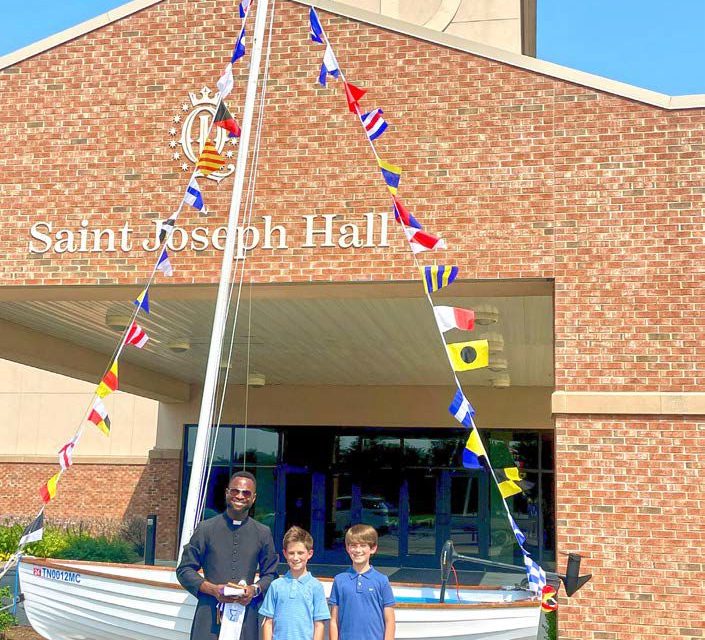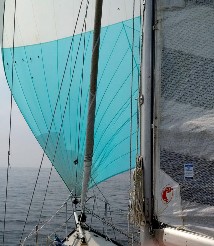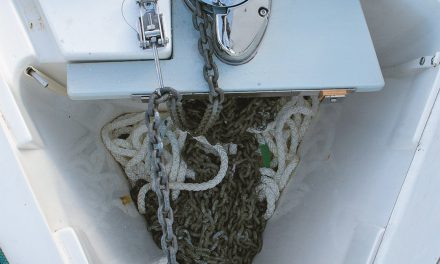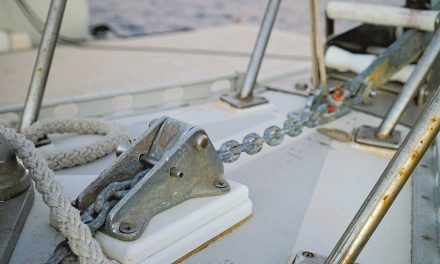A Montgomery 12 becomes a family project that perpetuates the love of sailing.
Issue 155: March/April 2024
Restoring a 1974 Montgomery 12 sailing dinghy with my identical twin boys, Jackson and Connor, was a way to feed our love of sailing and for all three of us to pull away from our electronics and spend time together working in the garage.
While our project started during the summer of 2022, when the boys were 11, our fondness for sailing and the water began long before. Jackson and Connor began sailing with my wife, Mendy, and me at the Boulder Yacht Club on Carlyle Lake in southern Illinois. They were 2 years old, which was challenging at times, but we found a way to make it work. We would anchor our 1982 Hunter 25 and let the boys swim and play at the beach. When it was time for some rest, my wife would put them down in the cabin for a nap, then we would weigh anchor and sail as much as we could before they woke up. We learned early on that wearing them out at the beach made for much more peaceful sailing.
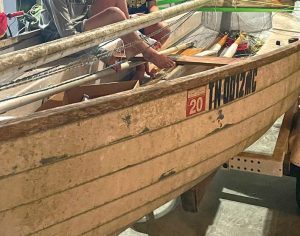
The family’s new-to-them dinghy was in rough condition when they brought it home.
As Jackson and Connor got older, the boat’s interior transitioned from a nursery where they would nap to a full-size pirate ship cabin. The first order from the little scallywags was to put up the pirate flag. While Mendy put on their life jackets, I dutifully hoisted the Jolly Roger. We learned a lot on that first boat, including how to dock when your outboard runs out of gas, getting to know every old sailor (they know every trick), and the importance of packing enough animal crackers to feed every seagull in the region.
On one of our memorable excursions, we ran aground under sail. The boat came to a complete stop fast and spun around. The boys came up from the cabin wanting to know if we were going to sink. In the back of my mind, I thought, “I sure hope not!” The forgiving bottom of Carlyle Lake is mostly mud; thankfully, we didn’t sink that day.
Since then, we have had three moves, from Missouri to Texas and now to Tennessee, and sailing has remained a cornerstone for our family no matter where we are living. We have owned several cruising sailboats, upgrading every few years when we could. Each boat had its own character and challenged us in different ways. Spending nights in our Com-Pac 23, Melinda Leigh, on Galveston Bay was one of the most memorable experiences. We would spend the day on the Kemah Boardwalk, a theme park with rides, shops, and restaurants, then anchor out in the bay and sleep on the boat. On one occasion the boys forgot stuffed animals, so we had to win some at the boardwalk before setting sail; luckily, I am really good at balloon darts. Several years later, the boys still refer to that day as the best day ever.
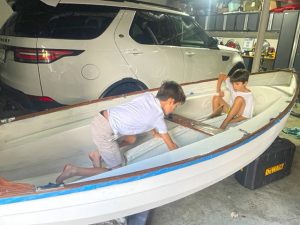
Many weekends were spent working on Daisy Mae in the garage.
Such experiences fueled my boys’ love of the water and sailing. But they really found their passion for sailing at the Houston Yacht Club, where at age 7 they began solo sailing. They attended sailing camp, learning to sail on Optimists. Since then, they have been honing their skills at Harbor Island Yacht Club in Nashville, and of course with us on the family boat. Their love for pirates has not diminished — they wanted to get the Optimist named Black Pearl every day at camp.
Shortly after sailing camp in 2021, they asked if I would get them a little boat of their own. My first response, like that of every good husband, was, “Let me talk to your mother.” I was probably more excited about the idea than they were. I grew up working on old boats and know the sense of pride and wealth of knowledge that come with putting in the effort yourself. My dad taught us the value of hard work and the importance of appreciating what you have; both were important qualities for me to instill in my children.
That night, I searched Facebook Marketplace for a small project boat. I wanted an Optimist or a Sunfish, but couldn’t find any that were within our budget. We live seven hours from the nearest coast, so there are fewer used boat options in Tennessee than we had in Texas.
After about a week of searching, I finally found a Montgomery 12 that needed a lot of love. It had been behind a barn for several years, and its owner was moving and needed to get rid of some of his treasures. It had been a club race boat before the man bought it, and the little boat had a lot of nautical miles under her keel. The Montgomery came with the club’s race harnesses, and since the owner was moving, also a lot of extras. We were excited to get his boxes of hardware, lines, rigging, oars, and more. The harnesses were what Jackson and Connor were most excited about. They wanted to do more racing and were pretty sure their newly acquired boat would be the fastest at Harbor Island Yacht Club.
We spent almost a year of Saturdays and some weeknights working on the Daisy Mae, named after the boys’ Goldendoodle. I think their mother was a little disappointed about this, as our big boats have always been named Melinda Leigh after her. However, Daisy Mae was the name they both wanted. Their grandmother quickly got to work making lettering for the stern, and also thought the boat needed proper seat cushions. The boys made stencils out of butcher paper and we sent them to their grandmother and a friend, who made beautiful custom seats that attach to the bench.
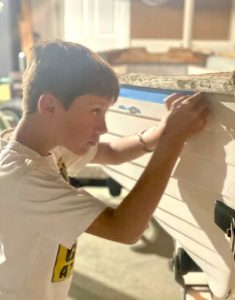
Taping the hull to prepare the gunnel for sanding and varnish.
Overall, Daisy Mae needed a lot more than new seat cushions and lettering, including both wood and fiberglass work. Thankfully, we could do most of the work ourselves. We began sanding, stripping, painting, and varnishing. I figured it would be easier to tape the wood when we painted the hull than to do the reverse and tape off the entire boat. After nine coats of varnish, the brightwork shone like it was coated in glass.
From there, we cleaned and sanded the hull and watched a few YouTube videos on rolling and tipping and the best paint to use. There was a lot of discussion about hull color, and we landed on West Marine’s white. This was incredibly controversial between the two boys, since one wanted yellow and the other wanted white. Three rounds of rock, paper, scissors settled the decision.
When it came to the fiberglass work, we had to bring in an expert. There had been an attempt to repair the mast foot in the past, and it either wasn’t done correctly or over several years of the hull being full of water, the “repaired” fiberglass had begun to peel up and was providing no physical strength or protection for the cedar core.
One weekend, the boys’ grandfather drove down from Illinois to help lay the new fiberglass on the bottom of the boat. We removed all the old repairs, exposing the cedar core, and then laid down the fiberglass. Fortunately, the bottom of the boat was solid, and it was only the top layer that was an issue. The cedar was still strong and appeared to be unharmed by years of exposure to the elements.
The boys learned a lot throughout that year of boatwork. Not only did the boat need attention, but the trailer also needed new bunks, lights, and wheels. I think everyone should know simple wiring and how to change a tire, and this was certainly a fun way to learn. One of the things they learned was the importance of making a list prior to driving to the hardware store. After multiple trips to Tractor Supply and the hardware store, we were able to change the wheels and also purchased the supplies to cut and wrap the new trailer bunks. Using the staple gun to cover the bunks with carpet was a big hit.
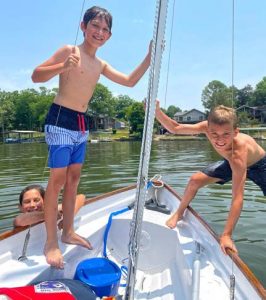
With no wind, the dinghy makes for an ideal swimming platform.
Finally it was time to put everything together. A challenge I hadn’t thought about was rigging a boat that came in pieces and without instructions. I spent a lot of time on the computer looking at pictures of Montgomery 12s to see how to set up the boat. What I learned was that it is way easier to simply pull into the yacht club parking lot with a project than it is to try to figure it out on your own. There were many sailors eager to help us get her sailing, and through their generosity, we came up with the hardware we needed to get the sails up.
The final thing the boys thought the boat should have is a motor. For Christmas, their uncles Travis and Derrick bought them a trolling motor and a battery; Daisy Mae was complete and ready to sail.
We were finally able to take her for a sail in January. Nashville in January is cold, but the boat was finished and the boys wanted to go sailing, no matter how chilly it was. I told them the weather had to be above 50 degrees before we could go out. They diligently watched the weather, and as soon as temperatures hit the mark, we were on the water. It took a little while to get everything working as it should, but in the end, we were able to sail around the cove near our house.
Since then, we have had a lot of fun on Daisy Mae, and she turns a lot of heads. We officially christened her on Aug. 19, 2023, on Old Hickory Lake near Hendersonville, Tennessee, with the pastor at Our Lady of the Lake Catholic Church, and the chaplain of the boys’ school, officiating the blessing.
Jackson and Connor couldn’t be prouder of their little boat. When we took it to Harbor Island Yacht Club for the first time, you would have sworn that they had just sailed in with a million-dollar yacht. They were beaming with joy, and I was a little proud myself.
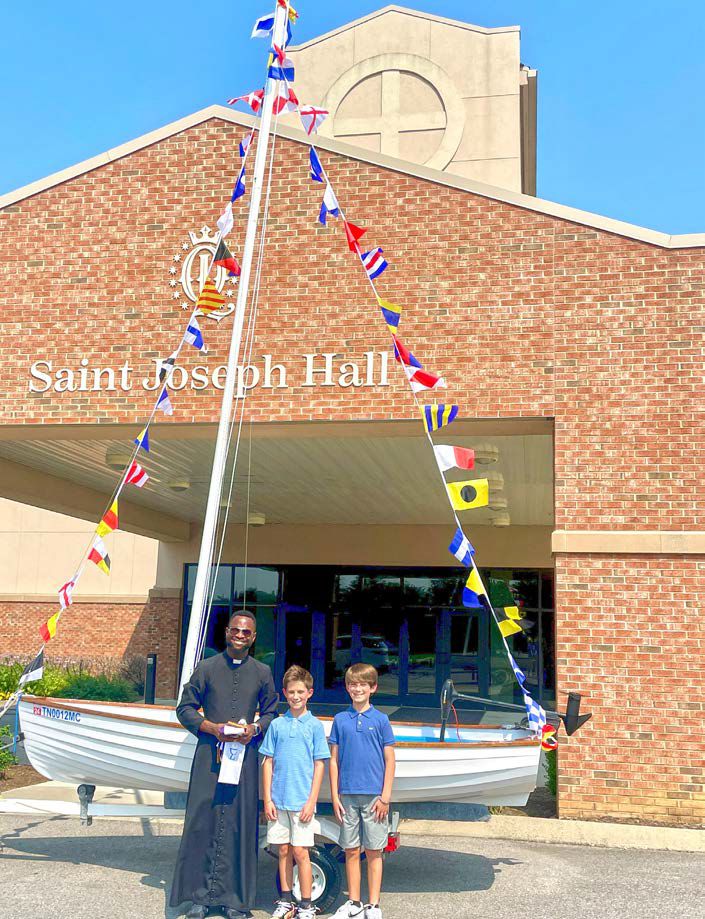
Finished and decked out in full regalia, Daisy Mae receives her blessing.
Clint Koerkenmeier and his sons, Jackson Koerkenmeier and Connor Koerkenmeier, restored a Montgomery 12 in their garage. The boat is named Daisy Mae after their Goldendoodle. Like the boat project, this story was a joint effort and was written by the three of them.
Thank you to Sailrite Enterprises, Inc., for providing free access to back issues of Good Old Boat through intellectual property rights. Sailrite.com

